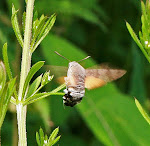In this area of north-west England the Common Darter (Sympetrum striolatum) is quite frequent, especially in the lowland areas, but the confusingly-similar Ruddy Darter (Sympetrum sanguineum) appears much more scarce. The Ruddys have moved into the county in fairly recent times and are slowly spreading northwards through Cumbria.
The males of both species are red and quite similar to each other and so also are the yellowish females. Fortunately, both species perch readily and allow a close view to be obtained.
The male Ruddy Darter especially, is perhaps most easily distinguished from the Common Darter (Sympetrum striolatum) in having jet black legs (yellow-striped in the Common), by the presence of a conspicuous black line running down the sides of the frons (absent in the Common), having deep red eyes and frons, a blood-red (not orange-red) more waisted abdomen and a rufus thorax.
.jpg)
.jpg)
[Ruddy Darter, male, both above: the completely black legs, the dark line running down the side of the frons and the deep red eyes and abdomen, can be seen]
.jpg)
.jpg)
[Common Darter, male, both above: the yellow-striped legs, the absence of a dark line running down the side of the frons, the paler more brown eyes and the orange-red abdomen, can be seen]
Ruddy Darters appear to favour sheltered vegetation near choked ditches and pools where the males will perch and often return to the same place if disturbed. Ruddys are also noticeably smaller than Common Darters and are more prone to hover. The Common Darter has a tendency to rest on artificial surfaces as well as on vegetation but this doesn't seem to occur anything like so much with the Ruddy Darter.
Thanks are due to Allen Holmes for helpful discussion on some taxonomic points.
.jpg)






Excellent ID photos - thanks
ReplyDelete